After months of extensive preparation of both body and mind, it’s time to embark where few have dared, to the farthest reaches of Earth. Discovering the coldest, most extreme areas in the world and emerging triumphant means going head to head with the unforgiving nature and even yourself. From being engulfed in solitude and relying on only yourself to survive, to chasing the Northern Lights, when you can feel the whisper of electricity in the air — polar exploration will shake you to your core and keep you coming for more. And no one knows this better than polar explorer Dixie Dansercoer.
Dixie is a certified IPGA Master Polar Guide, the author of more than two dozen books on polar exploration, and has been adventuring to our planet’s polar regions for over 30 years. Yet, Mother Nature kept him humble. We sat down with Dixie to discuss the makings of a polar explorer. We asked him about his history with polar exploration, what the various levels of polar exploration entail, the climate, the gear, the snowkiting, the food and more. Here’s what he had to say.
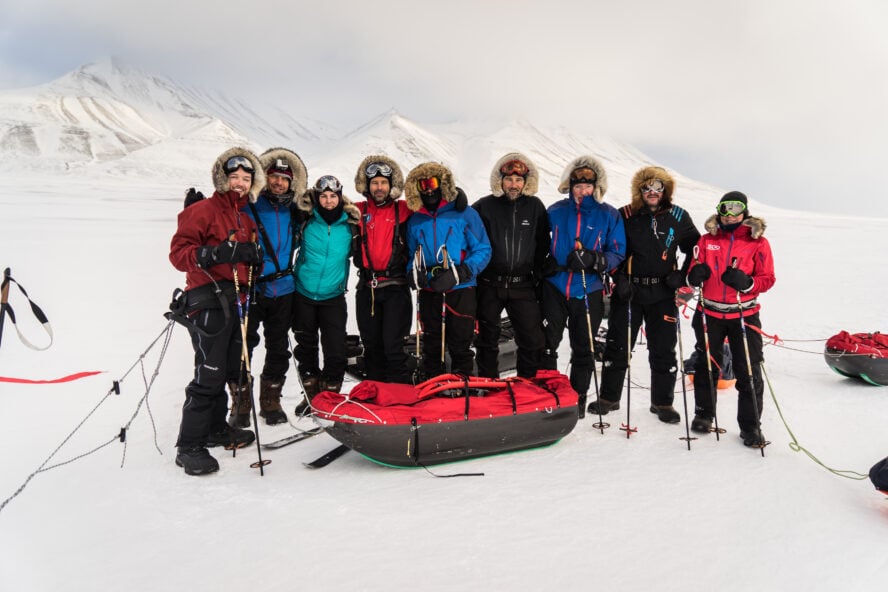
Who was the first polar explorer?
The turn of the 20th century is really where the birth of polar exploration began. Among other explorers of the time, Norwegian explorer Roald Amundsen really stands out. He was the first person to reach the South Pole in December, 1911, beating out American explorer Robert Falcon Scott by a month, and also the first person to voyage through the Northwest Passage by ship and the first to fly over the North Pole.
By beating unimaginably difficult conditions and odds that were stacking up against them, these first polar explorers paved the way for us to explore the same desolate places. While there is something special in beating the elements like they did in the old days, embracing technology made polar exploration much more doable. Today, we can board a plane or a sailboat that will take us to our location without the same difficulties they faced back then, but still, the same sense of accomplishment prevails.
I want to keep the memory of those pioneers alive in my expeditions. There’s always going to be an easier and faster way to reach the flag, but this way of thinking only steals from the true polar exploration experience. Even though we traverse in ways unimaginable to the first explorers, a century later, the feeling of inescapable cold and being cut off from society and all its luxuries remains the same.

What does polar exploration mean?
From Arctic expeditions to the North Pole to adventuring to the South Pole on Antarctica, polar exploration involves venturing to the coldest and remote environments on Earth. But, it’s not just solely the poles that I put in this category; I consider any region with a polar climate worthy of exploration. Whether that’s remote Siberia in Russia or the island of Svalbard, Norway, if it’s remote and cold, to me, it falls under the category of polar exploration. It takes months of extensive preparation — both physical and mental — to carry out an adventure like this. But I believe, with the right training and determination, anyone can become a polar explorer.
What does it take to become a polar explorer?
To become a polar explorer it takes months of extensive preparation. A person must develop both the physical and mental prowess to withstand days, weeks and even months in a remote, cold climate with limited food rations and only the necessary supplies. But it’s not something you jump right into. Like anything this specialized, you start with the basics and develop your skills until you reach your ultimate goal, whether that’s a two-week polar expedition to the North Pole or a month-long trek across Greenland, it’s all in how you prepare leading up to it.
What are the different levels of polar exploration?
There are three levels of polar exploration. The first level is beginner friendly; it’s for those who are curious about polar exploration, want to try their hand at it, but have no real experience with winter camping, mountaineering or anything of the like. Once someone completes an adventure like this, they’re ready to level up. The second level means more days spent traversing the ice, in even more impressive locations. Sometimes, my clients with sport backgrounds underestimate themselves and opt for the first level, when really, they can move up the difficulty scale and start at level two. It’s all about comfortability in the elements and the will to endure the elements. Once you’ve experienced life in nature’s freezer, having developed a deep understanding of the cold, you can then embark on a level three journey of a lifetime — exploring the North and South Poles.

What does Level 1 polar exploration involve?
Polar exploration can seem daunting, but in my experience, most people who set out to challenge themselves with an adventure like this have what it takes to succeed. To take any guessing or fear out of the game, I coach my clients on everything they could possibly need to know before joining the expedition. We discuss their physical readiness, mental state and condition of every item on the list in detail.
From there, explorers put into practice what they learn. A location like the scenic Swiss Alps is the perfect classroom for putting the theory to the test. By immersing yourself in tough winter conditions, you’ll gain an understanding of what it takes to explore the polar regions. Setting up your own camp and cooking food in limited facilities will prepare you better than any book. If you feel up to the challenge, improve even further by spending nine days high up in the mountains of Spitsbergen, Norway. You’ll travel across frozen fjords and vast fields of ice, learning valuable polar exploration skills firsthand.
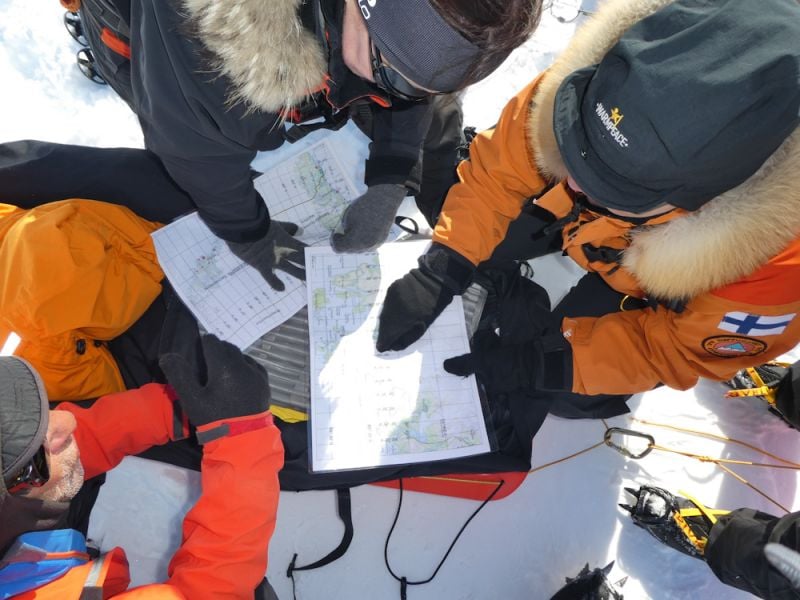
What does Level 2 polar exploration involve?
With some winter camping and mountaineering experience under your belt, it’s time for longer, more extreme adventures. After almost 30 years of polar exploration, I thought I’d seen it all. Then, I travelled to Siberia, Russia and took my first steps on the frozen surface of Lake Baikal — the oldest and deepest lake on Earth — and I was completely swept off my feet. This is an example of a Level 2 polar adventure. For 12 days, you get to witness the ice and oxygen create intricate designs under your feet, making it seem alive as you traverse it. Days spent sledging and crunching fresh snow and nights sleeping in warm tents, on a thick sheet of ice separating you from bustling marine life of the lake. At the end of your expedition, you’ll find yourself among shamans in the village of Olkhon, practicing their mystic arts to this day.

What does Level 3 polar exploration involve?
The big finale and final frontier for most polar explorers are the furthest reaches of Earth — the North and South Pole. Traversing the poles means coming face to face with the harshest conditions on Earth — ice on the brink of cracking under your boots, strong winter winds worsening the bite of already extremely low temperatures, and while many people conflate the two locations in their minds, they’re not the same.The Arctic and Antarctic have very different climates, pose different challenges, require different equipment, and even a different mindset is needed. Antarctica is a continent covered by a huge ice cap hundreds of kilometers deep; the Arctic is actually an ocean with a flimsy layer of perennial ice that’s constantly moving. The Arctic is far more humid and it feels colder. Salinity in the air is also an added difficulty. There are only part-time residents in Antarctica, while the Arctic is inhibited. In my opinion, there is no adventure in the world as epic as the expedition to the most northern point of the planet.
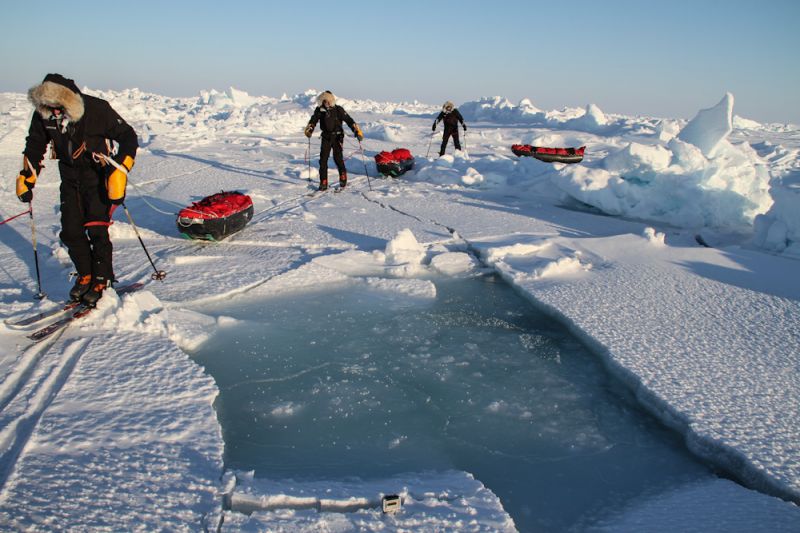
Are the polar regions vast nothingness?
The most important thing you need to know is that it’s not just one white expanse. You can discover colors, all sorts of fauna and flora, and hopefully, become an ambassador for the poles, a very precious part of our globe. Intense grays, deep blues and blinding whites make the landscapes look like paintings. Sometimes it’s the contrast of nothing; after hours of walking, a monumental ice structure arises from the horizon like a mirage on the horizon. It’s incredible.
In the Arctic, the ice you walk on is a shifting puzzle, splitting into leads, giving you glimpses of the deep, dark ocean beneath you. There’s so much to be seen away from the 360-degrees of nothingness. We often crawl into ice caves and grottos, discovering even more of Mother Nature’s stunning creations. No matter how many days you spend on the ice, there will always be something to see or do.
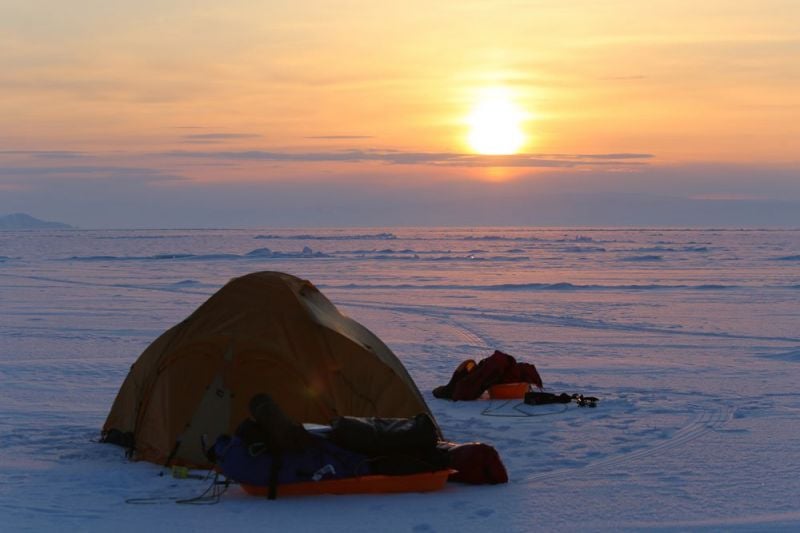
Are you alone on the ice?
We must always remember that we’re only visitors on these lands. I’ve had 14 encounters with polar bears, and each time it’s just as exciting as the first. It’s the reality of life in the Far North. As for being cut off from civilization, you will have plenty of time for introspection, that’s for sure. But it’s not all complete isolation. You will come across other parties, whether they’re locals or other adventurers. I’ve always loved running into local folks, be it Inuit people that inhabit the Arctic regions or friendly Russians that live near Lake Baikal.
Is walking all you do on polar expeditions?
Attaching crampons to your snow boots and pulling your pulka (a type of snow sled used for transport) is the basic means of traversing in polar regions. Polar travel has definitely upgraded from the Heroic era, though, as we have embraced many new technologies. In some areas we can even bike. In many areas, the ice is very slick, providing almost no traction, and if the wind cooperates, you can snowkite — one of my favorite ways to get around.
Snowkiting is like kiteboarding, but on land. We harness the power of the kite to glide across the ice on skis, being pulled by the wind much as you would be on water. Snowkiting allows us to progress much quicker across the land without investing as much energy as we would by manhauling the pulkas. I find that a good daily average for snowkiting is somewhere between 75 and 100 km. On exceptional days, with perfect conditions, we’ve been able to cover 200 to 400 km per day.
It’s not just about how we get around. There is also much to do while on expedition. The towering ice structures are begging to be climbed. A member of my crew wanted to jump from an iceberg and go for a dive, and he did! One of my favorite activities was kiteboarding in Antarctica, with mega glaciers serving as a backdrop. It’s an image that’s going to stay with me forever. For those looking for a more serene way to explore their surroundings, paddling under the midnight sun is an unforgettable experience.
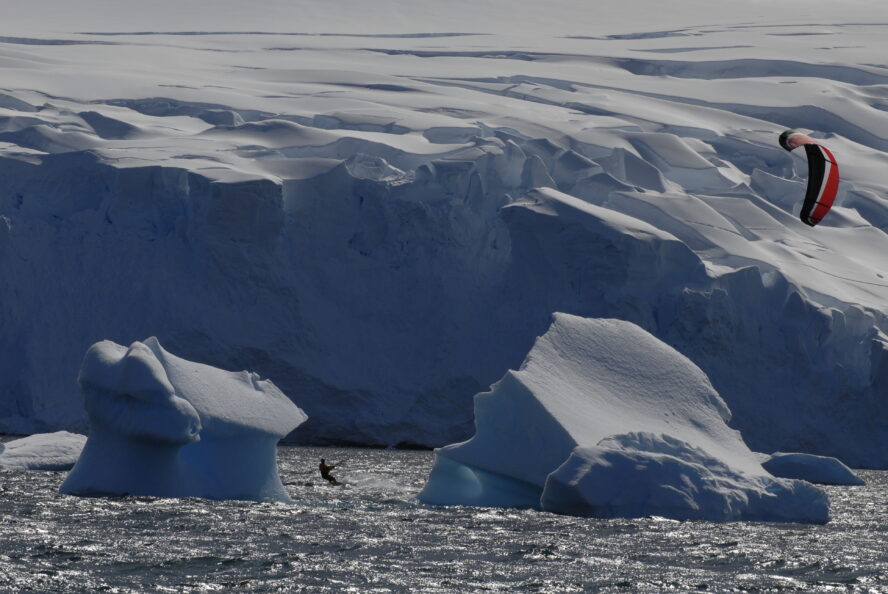
What do polar explorers need?
The equipment list for polar exploration is very specific. Some items are easier to come by than others. It ranges from your standard winter camping gear to specialised gear designed for extreme conditions. Prior to the expedition, I’m in constant contact with my clients, ensuring every single piece of equipment is in perfect condition. The last thing you want is a malfunction while on the ice. This is why I take care of the logistics; all my clients need to bring are personal items and clothing.
When it comes to dressing appropriately for polar expeditions, layers are your best friend. Our number one mission is maintaining a walking tempo that doesn’t make us sweat. You’ll actually want to avoid moisture-wicking clothes, as they’ll only make your sweat vaporize and freeze, and your clothes need to be frost-free at all times. Every 50 minutes we have a 10 minute break to catch our breath, shake off any frost, and reapply chapstick to prevent frostbite on sensitive areas, like your lips.

In addition to the right gear, polar explorers need perseverance, ambition and a deep understanding of themselves and the habitat they wish to explore. Surviving in polar regions requires military-like diligence and months of extensive preparation. Making sure your body is a well oiled machine is essential, too. However, the most important factor that will make or break your expedition is your mind. Thorough research, crossing items off your packing list and setting your tent up in record time will make you feel more confident on the ice, but it all comes down to studying yourself. How will you carry on when your energy depletes? Will loneliness eat at you? What motivates you? Building mental strength is even more important than building muscles. Polar exploration is 20% physical and 80% percent psychological.
How fit do you need to be?
In the decades I’ve spent leading people on adventures, I have only asked a few people to postpone their polar expeditions. I’ve seen humble people who doubted themselves thrive, and confident Iron Man champions struggle. It’s all in your outlook. Of course, a certain level of fitness is needed to complete the trip, but you don’t need to be an Olympic athlete to try. Polar expedition training consists of a regimen of workouts — biking, skiing or even walking for a few hours a day does the trick.
As long as you’re honest with yourself and the others about your abilities, there’s nothing stopping you from succeeding. It’s much more important to be a compassionate person and a team player who’s willing to admit they need a break or something to eat. Those are the qualities that make a polar explorer.
What’s it like to camp on the ice?
It’s no secret, the polar regions are a tough environment. When the day is over and you’re back in your tent, it’s like being engulfed into a bubble of warmth. For the first time in hours you get to relax, eat a filling meal and take refuge from the harshness of the terrain. It’s a wonderful opportunity to regain focus and reflect on things that matter the most to you. The tent itself resembles an igloo and houses two people, with enough space for you and your equipment. Going back to basics really allows you to get away from the rat race that is materialism. I promise, it will change you.

What do polar explorers eat?
One of the first questions people ask me is, “What do polar explorers eat?” The answer might be surprising — everything! Dried chicken, cheese, soups or even chocolate; pack whatever your heart desires.There are freeze-dried versions of practically every food available, you really don’t need to compromise on anything. Polar expeditions are hardly a time for dieting. The rule of thumb when choosing what to pack is that it contains loads of fat, proteins and carbohydrates. The cold eats at you, and keeping your engine running is vital, both for reinvigorating your body and for maintaining a healthy body temperature.
Is the ice melting?
Unfortunately, the old saying, ‘out of sight, out of mind’ applies here. Being so desolate, the North and South pole are often forgotten, but crucial reminders that our climate is indeed changing. Even the harshest of environments are delicate ecosystems we need to preserve. Seeing the once impenetrable permafrost melt and glaciers crumbling is a wake up call. We do whatever we can to help scientists better understand the changing climate. Parallel to completing the expeditions, I reserve anywhere from 30 minutes to two hours of my day to collect data from the ice and snow we traverse on. It’s a small favor that benefits the public at large.
I’m interested, what’s the next step?
Polar exploration is a once-in-a-lifetime experience. It’s not just for the die-hard extreme adventurers; there really are options for almost everyone. It all starts with a conversation. To make sure it’s done right, the first step is assessing your fitness and level of experience, as well as discussing your goals. Then, it’s about choosing the expedition that’s right for you — whether that’s starting with the foundations of Level 1 or opting for something more intense like a Level 2 or 3 adventure. The preparations start six months prior to the actual expedition date. This gives us enough time to take care of the logistics and work on developing your physical abilities. As intimidating as it might seem, exploring the polar regions is an enriching experience that will make you appreciate the world and people in it with new ardor. I truly believe that if someone has the will and determination to successfully complete a polar expedition, they can do it! It’s all about taking the right steps to get them there.
For a more in-depth look at polar exploration with Dixie, watch his 57hours Adventure Talk, where he goes into great detail about his trips and experiences, complete with photos and and advice on how you can train and take on your first polar adventure:



